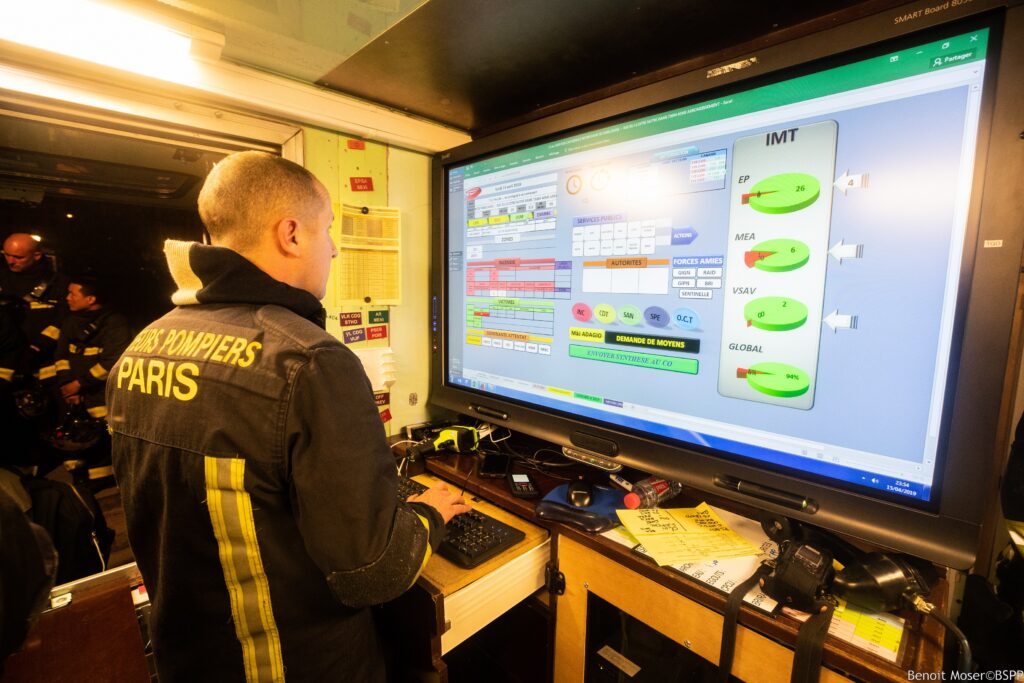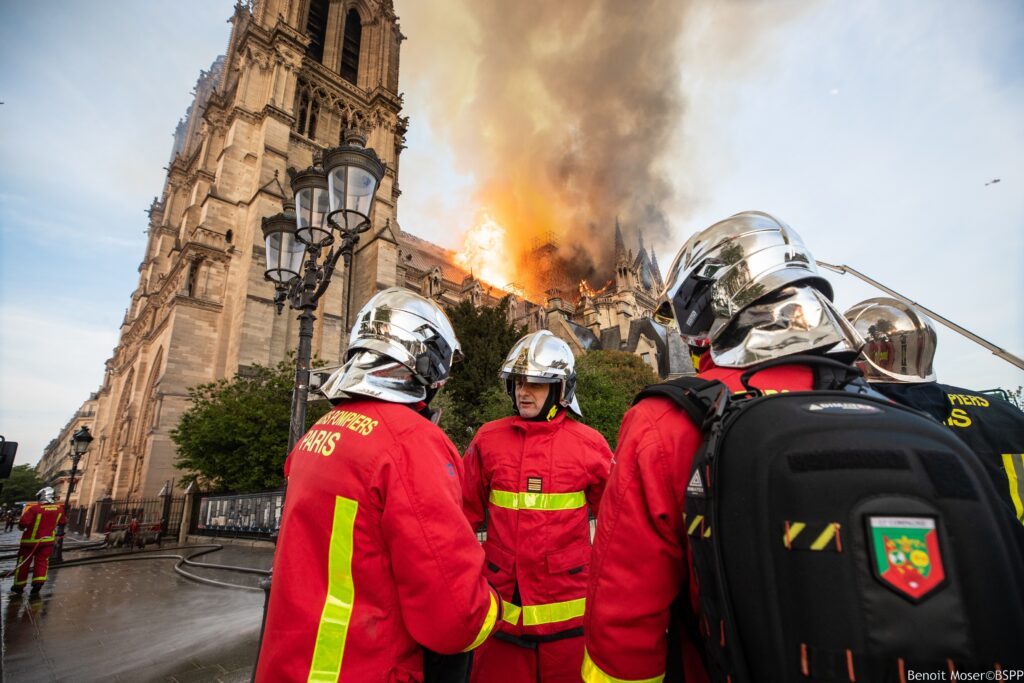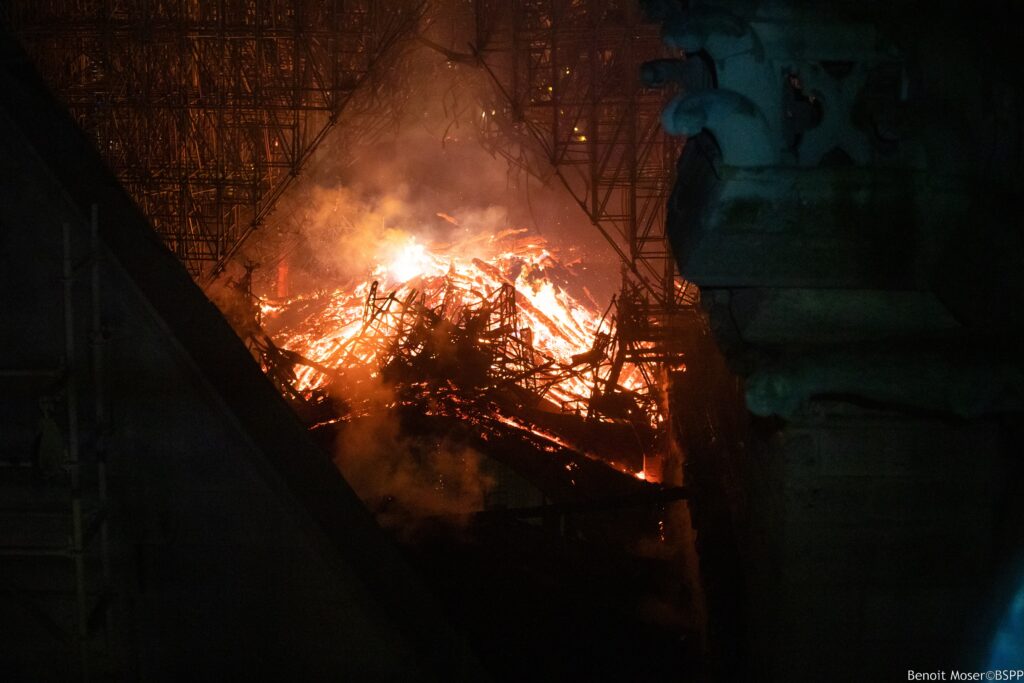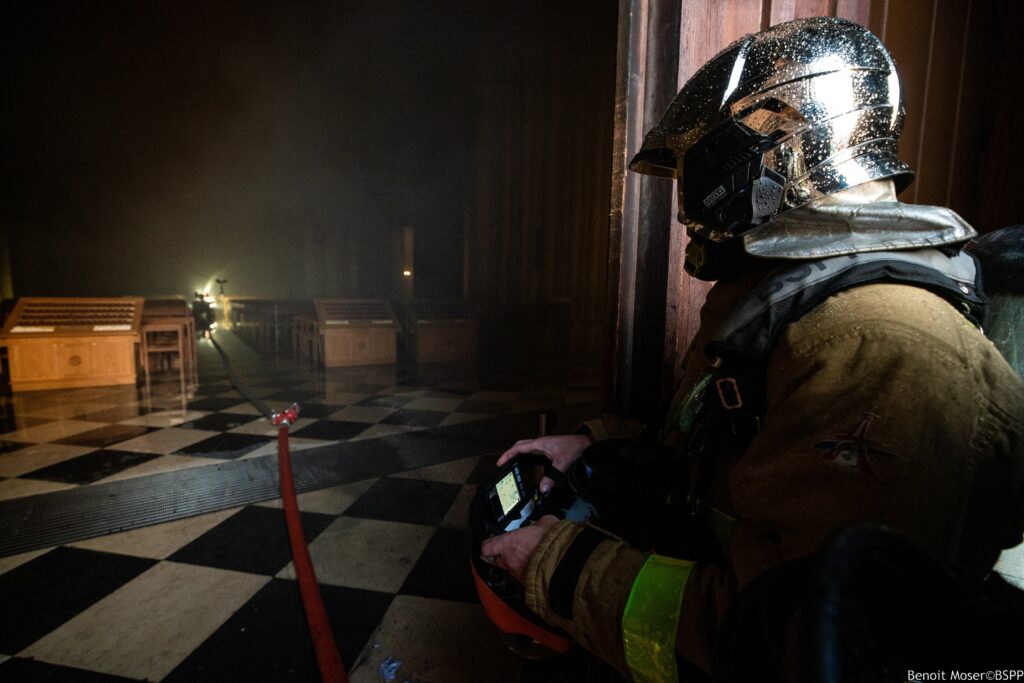By Romain Kimmel, Foreign Policy Officer at French Ministry of Interior – DGSCGC and PROCULTHER Focal Point (1)
Special thanks to the Brigade des Sapeurs-Pompiers de Paris for providing the technical information and photos of this intervention
In 2017, France had more than 45,000 protected historical monuments. In the event of disaster, civil security forces are called to intervene to protect threatened property in accordance with the law on the modernisation of civil security of 13 August 2004. Therefore, on the night of 15 to 16 April 2019, during the fire that ravaged Notre-Dame Cathedral in Paris, all public players mobilised to help manage the disaster and save this emblematic monument.

The Paris Fire Brigade (Brigade des Sapeurs- Pompiers de Paris – BSPP), ordinarily engaged in the rescue of people, played an essential role in this intervention that involved also the Departmental Fire and Rescue Services (SDIS) of the Yvelines and Seine-et-Marne as well as the Operational Centre for Inter-ministerial Crisis Management (Centre Opérationnel de Gestion Interministérielle des Crises – COGIC), the police forces and representatives of civil society (such as specialists in the safeguarding of cultural property). The interoperability of the State’s services concerned by cultural heritage protection, made possible by interdisciplinary training programs and shared intervention methods, was a determining factor for the management of the crisis. These conditions helped facilitate the arrival of emergency services, the implementation of assessments, the coordinated scaling-up of conventional and specialised resources, the anticipation of handover, the reinforcement of the command cell and the planning of the different phases of this operation.
The genesis and sequence of events

On 15 April 2019, at around 18h45, the emergency services were alerted for a fire that broke out beneath the roof of the Notre-Dame Cathedral spire.
The BSPP was organised around The BSPP’s tight operational network enabling the deployment of a large number of human and material resources within the first half hour: finally, a total of 600 Paris firefighters (400 in direct combat and 200 with logistical or command functions) were mobilised during this intervention. Moreover, from the outset, the COGIC, under the authority of the General Directorate for Civil Security and Crisis Management (DGSCGC) of the Ministry of the Interior, covered a significant coordination role both in monitoring and informing the authorities. The COGIC coordination made possible the alert and take-over of the Groupe d’Interventionen Milieux Périlleux – GRIMP (Group for Intervention in Perilous Circles), facilitated the dispatch of 40-metre-high Articulated Lifting Arms (ALA) and the deployment of 20 expert firefighters within the framework of mutual support protocols with the Departmental Fire and Rescue Services (SDIS) of Seine-et-Marne and Yvelines. In addition, the expertise of other specialised groups, such as the Urban Search and Rescue team (USAR), the Cultural Heritage Protection Unit and the long–term exploration teams supported the intervention by the personnel in charge of the site security according to the Cultural Heritage Protection Plan- PSBC (Plan de Sauvegarde des Biens Culturels), thus enabling Notre-Dame’s treasure to be secured.

While the emergency operations commander decided to create four operational sectors to surround the fire, at around 19h30, the spire of the Cathedral – an addition designed by the architect Eugène Viollet-le-Duc in 1859 – was engulfed in flames and was threatening the architectural structure of the site. Therefore, the emergency operations commander ordered to withdraw the personnel involved in the upper part of the building to concentrate and reinforce the attack force outside the building. At the same time, a detachment of the BSPP, in coordination and with the assistance of the staff in charge of the site security, succeeded in securing the treasure and the many art works of Notre-Dame at the Hôtel de Ville and the Louvre. At around 21h, the situation got worse: the fire threatened the north and south belfries, endangering the stability of the bells, whose fall could have caused the towers to collapse. The objective of saving the Cathedral’s façade became the operational imperative, which is why several teams were deployed in the stone stairs of the north belfry. It was this concerted decision, taken at a key moment, that saved the building. At 21 h 45, the various reports from the sector leaders finally confirmed the containment of the spread. In the meanwhile, the security architects of the Prefecture of Police and of the historical monuments surveyed the building to assess the level of damage to the architectural structures, to identify the areas at risk and to inform the commander of the emergency operations. At 22h30 the fire was considered contained and by 2h it was declared extinguished; from then on, the surveillance system was sufficient to deal with the residual outbreaks. Concern was then expressed about the stability of certain structural parts of the Cathedral and, to detect any possible oscillation, it was decided to install laser telemeters in the north and south transepts of the building. At 2h30, a surveillance system of eight lances still operating intermittently, and deployed in four sectors, was gradually taking over from the attack system.

Finally, since the morning of 16 April, the BSPP has been helping to monitor the burnt areas and protect the Ministry of Culture experts responsible for securing the entire weakened building at risk of collapse. The final collection of artworks that have been saved is reassuring and there is nothing irretrievable among the 1,500 works housed by Notre-Dame: a total of 56 items were evacuated, including the Boucheron crown, the Shirt of Saint Louis, a piece of the Holy Cross, and the famous crown of thorns, as well as the choir’s precious works, the sacristy, and the most valuable relics from the treasure room.
After a situation update on the next steps to be taken with the security architects, experts in historical monuments and the fire-fighters, an in-depth visit of the site made it possible to deal with the disaster from an architectural perspective with an interdisciplinary approach. It was then decided to remove the north transept of the cathedral within 48 hours, that the two front gables of the Cathedral and the attachment beams of the north belfry bells were to be reinforced in the coming week.
Other successful elements of the action also include a mixture of traditional techniques, such as the work of the operational designer who prepared on site the sketches representing the intervention priorities transmitted in real time to the Command Post, and of high-tech tools, such as the extinguisher robot used inside the Cathedral and the drone equipped with an infrared camera which revealed the progression of hot gas flows under the roofs.
In conclusion, the Notre-Dame de Paris fire revealed the extent of the risks threatening Cultural heritage. Faced with this preservation challenge, the conservators and protectors of historical and cultural assets are being engaged to ensure the safety of buildings through prevention, forecasting and support by the various stakeholders. To these measures, since 2005, the organisation of the civil security response – ORSEC has added the essential PSBC which consists of several steps: risk analysis, artworks classification according to their value, preventive storage sites for the evacuation material and the personal protective equipment, training of personnel, etc.
The keystone of the very conception of crisis management affecting cultural heritage was set in 1994 when, after a fire at the Parliament of Brittany, the French Ministry of Culture, in cooperation with the BSPP, decided to create the Service of Fire Prevention Advisors (MISSA). This office is made up of three experienced staff profiles, all having a specialisation in museums, heritage, and training. Their role consists in monitoring, advising, and training around this topic. Every five years or so, the places of worship in France (86 cathedrals, two basilicas and one church) are visited by the heritage fire safety advisor, who checks their safety regarding the fire risk, the conditions for intervention by the emergency services, and the updating of the PSBC. All these actions are undertaken in coordination between the fire prevention advisors and the sites managers; in the case of a cathedral, it is the architect of the buildings of France (ABF) who is the sole responsible for security (RUS). These experts must consider several factors that complicate their tasks: fire regulations in cathedrals are limited to the essentials and many of them are not equipped with fire detectors. The Ministry must therefore adapt its security arrangements to the heritage issues at stake: Notre-Dame de Paris, for example, is the only place of worship protected by a central security station (PCS) and has one of the best fire safety systems, three security guards during the day and a night guard.
(1) Original version of the article in French
Source: Allô 18 – MAI – JUIN 2019 | HORS-SÉRIE Magazine by the Brigade des Sapeurs- Pompiers de Paris






